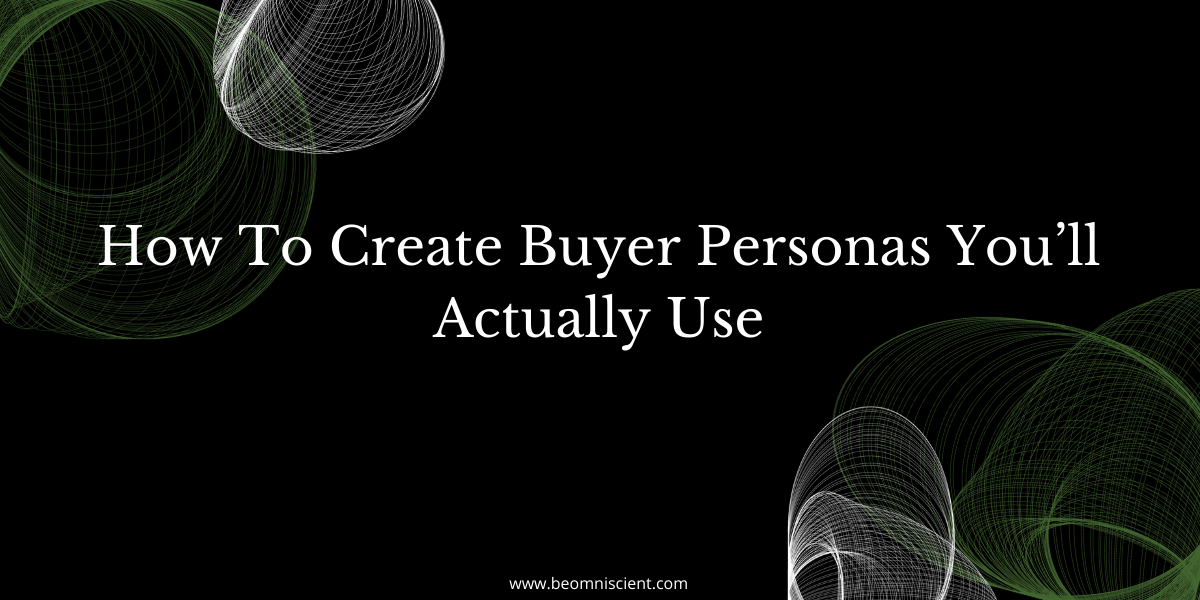
Here’s a staggering statistic.
In a survey conducted by content marketing consultant Adrienne Barnes, 85% of marketers said they create buyer personas.
Want to know how often they used them? 77% said never.
Not for product launches. Not when starting new campaigns. Not any other time when you’d think a persona would be useful.
The cold reality is that traditional buyer personas have become a “check the box” marketing practice.
That’s why Adrienne created Best Buyer Persona — to reimagine how personas are created and the purpose they serve. She recently sat down with me and explained how brands can turn personas into the most valuable tool in the marketing toolbox.
View buyer personas with a critical lens
If the buyer persona isn’t being used, should we even make them?
“If it doesn’t make sense, if we’re not using it, why waste time?” Adrienne said. “Why waste four hours even doing it?”
It’d be simple enough to say we should stop altogether. But the truth is that you do need to do something to find out more about your customers before you try to market to them.
It just needs to be different from what’s always been done.
The old way of creating “Mary Marketer” with her dating-profilesque details (age, race, pets, location, etc.) doesn’t inform business decisions or inspire content.
Instead, you want a persona where every inch of it serves to inform something about your marketing and content strategy.
“It’s either going to inform a product development or a new feature, or how customer success can help and support a customer on a call, or how a content marketer could take this and say, okay, I’ve now got 28 ideas that I know, pieces of content I can now execute on and go off,” said Adrienne.
Conduct interviews to create a content strategy
To create a buyer persona that becomes a functioning piece of marketing strategy, start by conducting customer interviews.
Adrienne asks targeted questions that will give her the information she needs to take action.
From the answers, she gathers customer frustrations and aspirations, as well as what she calls relational keywords. Those items become pages in the buyer persona document.
Do they cite frustrations or ignorance? That becomes “how-to” content.
Do they share aspirations or delight? That becomes a case study or testimonial.
In this way, Adrienne is able to draw a clear line between what customers like and dislike and the resulting content that needs to be created.
“Every question I ask, I’m linking it to now, what kind of piece of content could that be?” she said.
The answers can inspire all kinds of content strategies.
Adrienne sometimes conducts small 5-6 person interviews specifically for content marketing. Those are used to figure out what current content customers engage with, and what content needs to be created.
If they share that they love your white papers, but don’t know about your infographics, podcasts, or fireside chats, that tells you what matters to them.
“So then we’re able to say, okay, really we’re exhausting a lot of effort in creating a weekly blog post,” she said. “What we could do is create a monthly white paper and just switch our effort into original research.”
Identify relational keywords
Interviews provide Adrienne with another valuable asset: relational keywords.
She coined this term to describe the words that your customers use to talk about your product.
“I wanted to be able to identify what those were and highlight them and make sure that my clients knew that these were important terms,” she said.
“It just kind of occurred to me, oh, relational. Because they’re showing the relationship between the company and the client and their customer.”
These relational words should be used in your copy and to inform your content and SEO.
Here’s an example Adrienne shared:
Imagine you own a shoe store. All of your copy uses the word “shoes.” Then you do customer research and find out that your customers don’t use the word shoes to describe your product. They use the word “sneakers.”
It may seem like a subtle difference, but you should change your content and copy to reflect that.
“Not that people can’t understand that a shoe and a sneaker is a similar thing, but it goes along with that StoryBrand concept of: don’t make people overwork. Really give them simplicity,” Adrienne said.
One easy way to figure out what words your customers use over and over? Pop your interview transcripts into an online word-cloud generator.
The most frequently used words will immediately become clear. Those are the relational keywords you should use in your strategy.
Question content for content’s sake
Buyer personas that are based on truly getting to know your customers also help stop you from creating content for content’s sake.
It’s easy to get caught up in the idea that you need a new blog post every week. But that may not be the support your customer actually needs or wants.
“As a customer, there’s not one product I use, and I use quite a bit to run both businesses, that I’m like, Ooh, I need to check their blog every single week,” Adrienne said.
Your customers may not be waiting with anticipation to see your blog posts either. They’ll likely check your website when they have a specific problem or question.
“It needs to serve a purpose,” Adrienne said. “It needs to have a means to an end. So definitely in content marketing, there needs to be some just understanding and efficiency.”
There’s a lot of pressure to keep up a steady stream of content, and marketers work hard to turn out high-quality stuff. We assume people will want it. Customer research will help prove whether or not that assumption is true.
Use empathy to get rich interview responses
When Adrienne started Best Buyer Persona, she threw herself into learning everything she could about survey design, data analysis, and how to conduct an effective interview.
Her studies and experience have taught her what interview approaches will yield the richest answers, whether it’s a customer interview or a podcast.
She starts her interview prep by finding anything the interviewee has talked about before, whether on social media or through conversations with the company.
“I can say, well, you mentioned this premise over here, can you tell me a little bit more about that?” Adrienne said. “That ‘can you tell me a little bit more about that’ question is my favorite and the most powerful.”
The next thing is to lean into anything that triggers emotion, but in an empathetic way so that people are feeling heard.
If your interviewee talks about a hard time or challenge, empathize by saying things like “that sounds like that was hard.” And then follow up with the “tell me more” question.
“Having that empathetic response where you’re validating their feelings, they’re safer, they’re more comfortable,” she said. “You get me, now I’m going to open up a little bit more.”
Inspire interviewees to open up
There are other ways to make sure your interviewee feels comfortable talking to you and gives you honest answers.
Adrienne makes sure that the interview isn’t the first time they’re being introduced.
“What I like to do when I’m setting up customer interviews is the client will then introduce me,” Adrienne said. “So maybe they’ve got somebody that they’ve been emailing within the company or a company influencer who’s well-known.”
“I’ll have that person intro me. So I’m coming in warm.”
She also always asks the same question at the end of every interview.
“I ask them, so is there anything else I should know?” she said. “Is there anything else that you’d like to share?”
“For a customer discovery interview, that’s where they’ll end up giving me the greatest insights, the most concise language.”
When building out buyer personas, it’s crucial to understand your customers’ needs and desires in order to create the best content possible.
When you create better buyer personas that are built on a foundation of deep, authentic insights, you’re armed with what you need to execute a winning content strategy.
Knowing that Mary Marketer has a cat and loves ramen won’t do that.


